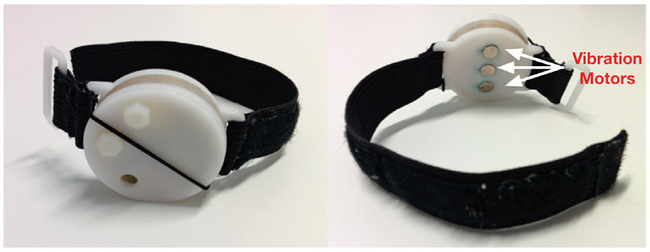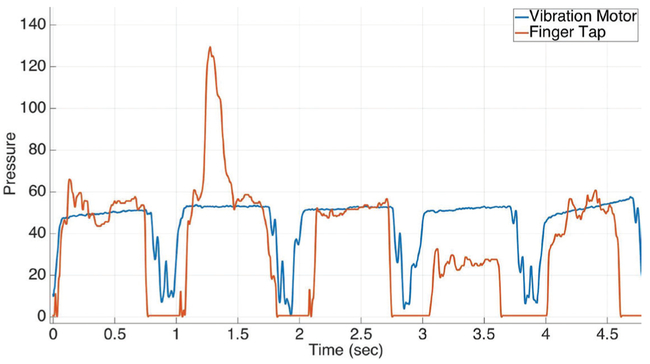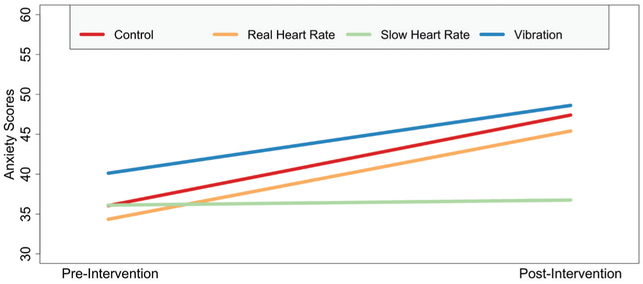Abstract
Previous studies indicate that the way we perceive our bodily signals, such as our heart rate, can influence how we feel. Inspired by these studies, we built EmotionCheck, which is a wearable device that can change users’ perception of their heart rate through subtle vibrations on the wrist. The results of an experiment with 67 participants show that the EmotionCheck device can help users regulate their anxiety through false feedback of a slow heart rate.
Emotions powerfully shape how we interact with the world around us. Most of the time our emotions serve us very well. In other situations, emotions can harm more than help, such as when an individual “freezes” during a presentation or when a person is propelled to hit another during an episode of anger. In order to avoid these situations, we make efforts to regulate our emotions to make them helpful, rather than harmful. This effort, through which we influence the emotions we have, when we have them, and how to experience and express these emotions, is called “emotion regulation” [1].
In order to help users regulate their emotions, researchers devised different technological interventions [2][3]. However, many interventions require too much attention and effort from the users, which may affect their concentration during ongoing tasks and even increase their stress [4]. These issues can counteract the positive aspects of the technologies and negatively affect the desired outcome. In order to address this issue, we propose a new approach for designing technological interventions for emotion regulation. This approach is based on previous studies that demonstrate a relationship between anxiety and the perception of our bodily signals, such as heart rate. Studies have shown that if an individual notices that his heart rate is very fast, this can intensify the feelings, making him feel more anxious [5]. On the other hand, if we supplement this information with another signal that indicates that the heart rate of the individual is slow, this may influence the way the individual appraises the situation, which in turn can make him feel calmer. Inspired by this idea, we designed and built EmotionCheck, which is a wearable device that influences a users’ perception of his or her own heart rate through subtle vibrations that resemble a pulse. We evaluated EmotionCheck through a laboratory experiment with 67 participants, and we found that it is possible to regulate user’s anxiety by providing false feedback of a slow heart rate.
EMOTIONCHECK DESIGN
EmotionCheck is a watch-like device that produces subtle vibrations on the wrist simulating heartbeats. Figure 1 shows a picture of the device. We decided to build EmotionCheck to have more control of the vibration intensity and the noise produced by the vibrations, which were important aspects since our goal was to simulate heartbeats in a subtle and non-distracting way. To minimize the profile of the prototype, we designed and built a custom PCB. Figure 2 shows the components present in the device.
FIGURE 1.
The EmotionCheck device.
FIGURE 2.
Diagram describing the components of the EmotionCheck device.
In order to control and communicate with the EmotionCheck device, we used a RFD22128 16MHz ARM Cortex-M0 microcontroller. The haptic feedback is driven by three shaftless/coin vibration motors (Precision Microdrives 308-107 Pico Vibe) connected to pulse width modulation outputs on microcontroller. Each of the two 8 × 2.15mm motors has an output of 0.75 G at 15k rpm. The intensity of the vibration can be compared to someone lightly tapping the inside of their wrist, as seen in Figure 3. In this experiment, the motors were fixed to a surface with 100 gram weight on top of them (to simulate the mass of the EmotionCheck device), then pulsed as they were in the study. We then did the same task but tapped a finger for the input instead of using the vibration motors. We used the vibration motors (held in the opposing hand) to help maintain a consistent rhythm and duty cycle. We ran a cross correlation on the two conditions, which resulted in a correlation score of 83.78 with a lag difference of 14 and lag time of 0.0140.
FIGURE 3.
Comparison of the pressure applied by the EmotionCheck vibrations and finger tapping.
EXPERIMENT DESIGN
In order to evaluate the effect of the EmotionCheck device, we conducted a laboratory experiment (n = 67, 43 female) with a between-subjects design. The experiment was an adaptation of the Trier Social Stress Test [6], and the participants were not informed about the true purpose of the study. All participants used the EmotionCheck device and a heart rate monitor (Polar H7). The experiment had three phases: a baseline phase (5 minutes), in which users watched a calming video; a preparation phase (5 minutes), in which users had to think about how they would describe themselves while applying for their dream job; and a presentation phase (5 minutes), in which they had to present themselves to a confederate who kept a neutral face during the entire presentation. Participants filled out a questionnaire about their state anxiety after the first phase (pre-intervention) and last phase (post-intervention) [7], and they also answered questions after the last phase about how they felt and how distracting the vibrations were.
The study had four conditions, which were randomized. The condition was activated in the beginning of the second phase, and it remained active until the end of the third phase. In the control group condition, participants did not feel any vibration during the tasks. In the vibration condition, participants felt the vibrations on the wrist at a frequency of 60 bpm. They were informed that they would feel vibrations on the wrist, but no additional information was provided. In the slow heart rate condition, participants also felt the vibrations on the wrist at a frequency of 60 bpm, but they were informed that the vibrations would always represent their current heart rate. In the real heart rate condition, participants were informed that the vibrations would always represent their current heart rate, and the vibrations were indeed changing based on the heart rate of the participant (collected using the Polar H7).
RESULTS
In this section, we present results focusing on the effect of each experimental condition on participants’ anxiety and how distracting the vibrations were for the participants. For a more complete presentation of the results and discussion, please refer to the original paper [8].
Effect of the Intervention on Anxiety
A two-way repeated measures ANOVA was performed to compare the anxiety scores across the four groups considering the two moments in which the anxiety data was collected (pre-intervention and post-intervention). Figure 4 shows an interaction plot that indicates how the anxiety scores changed in each group after the intervention. Descriptive statistics of the anxiety changes are found in Table 1.
FIGURE 4.
Interaction plot showing the changes in the average anxiety scores.
TABLE 1.
Descriptive statistics and effect sizes based on anxiety changes.
| Mean | SD | Cohen’s d | |
|---|---|---|---|
| Control | 11.35 | 11.4 | |
| Vibration | 8.5 | 8.97 | 0.28 |
| Slow Heart Rate | 0.65 | 8.45 | 1.07 |
| Real Heart Rate | 11.06 | 10.21 | 0.03 |
The ANOVA analysis revealed a statistically significant difference (F(3,63) = 3.37, p = .02). The pairwise comparisons revealed that the anxiety scores of the slow heart rate group were statistically significantly lower than the control group (p = .014) and the real heart rate group (p = .018). The effect size was large in both comparisons. The analysis indicates that the slow heart rate intervention was responsible for making the anxiety of the participants to be lower than in the control group. No statistically significant effect was found for the other interventions when compared to the control group.
Attention to the Intervention
In order to evaluate if the intervention distracted people’s attention during the tasks, we evaluated their responses to the question, “Do you think the vibrations distracted you?” The responses ranged from 1 (“Not at all”) to 5 (“Very much”). Most participants in all conditions reported “Not at all” when asked if the vibrations distracted them. In the slow heart rate group, 11 participants reported “Not at all” 5 participants reported “A little bit” and 1 participant reported “Somewhat.” When asked about the vibrations in the open-ended questions, most participants reported that they did not pay much attention to them. In the slow heart rate group, one participant remarked: “I felt the vibrations especially when I was sitting but most of the time I was too distracted to pay attention to them.”
CONCLUSION AND FUTURE APPLICATIONS
In this paper we demonstrate that it is possible to design subtle mobile interventions that can help users regulate their emotions without requiring much attention and effort from them. We designed and evaluated EmotionCheck, which is a wearable device that can regulate users’ anxiety by providing false heart rate feedback. The results of an experiment with 67 participants show that this simple intervention was responsible for keeping the anxiety of the participants at low levels when compared to the control group and the other conditions. While in the slow heart rate group the anxiety of the participants increased on average 0.65 points, in the control group, the average increase was 11.35 and in the other two conditions, it was 11.06 and 8.5. Furthermore, most participants reported that the intervention did not distract them at all. These findings offer promising possibilities for the design of technologies for emotion regulation. ■
Biographies
Jean Costa is a PhD student in Information Science at Cornell University. His research interests include designing, developing and evaluating novel technological interventions that help users self-regulate their behavior or emotions. Costa has a MSc in Information Science from Cornell University. Contact him at jmd487@cornell.edu.
Alexander Adams is a PhD student in Information Science at Cornell University. His research interests are sensors, wearable and ubiquitous computing, health technology, and behavior change. Contact him at ata56@cornell.edu.
Malte Jung is an Assistant Professor in Information Science at Cornell University. Before joining Cornell he completed a PhD in Mechanical Engineering at Stanford University and a postdoc at Stanford’s Center for Work, Technology and Organization. Malte leads the Robots in Groups lab, which explores how robots affect work in teams and how we might design robots that improve the social functioning of teams. Contact him at mfj28@cornell.edu.
François Guimbretière earned his PhD from Stanford University in 2002. After working at the University of Maryland, College Park, he moved to Cornell University, where he is currently teaching at the Information Science Department. His research interests are human computer interactions, interactive fabrication, and design. Contact him at francois@cs.cornell.edu.
Tanzeem Choudhury is an associate professor in the Department of Computing and Information Science at Cornell University. She directs the People-Aware Computing Group, which works on inventing the future of technology-assisted well-being. Choudhury received a PhD from the MIT Media Lab. Contact her at tanzeem.choudhury@cornell.edu.
REFERENCES
- [1].Gross James J. “The emerging field of emotion regulation: An integrative review.” Review of general psychology 2.3 (1998): 271. [Google Scholar]
- [2].MacLean D, Roseway A, and Czerwinski M “Moodwings: a wearable biofeedback device for real-time stress intervention.” In Proceedings of the 6th international conference on Pervasive Technologies Related to Assistive Environments, ACM (2013), 66. [Google Scholar]
- [3].Morris Margaret, and Guilak Farzin. “Mobile heart health: project highlight.” IEEE Pervasive Computing 8.2 (2009). [Google Scholar]
- [4].Adams AT, Costa J, Jung MF, and Choudhury T “Mindless computing: designing technologies to subtly influence behavior.” In Proceedings of the 2015 ACM International Joint Conference on Pervasive and Ubiquitous Computingy, ACM (2015), 719–730. [DOI] [PMC free article] [PubMed] [Google Scholar]
- [5].Pollatos O, Herbert BM, Matthias E, and Schandry R “Heart rate response after emotional Picture presentation is modulated by interoceptive awareness.” International Journal of Psychophysiology 63, 1 (2007), 117–124. [DOI] [PubMed] [Google Scholar]
- [6].Kirschbaum C, Pirke K-M, and Hellhammer DH “The ‘trier social stress test’– a tool for investigating psychobiological stress responses in a laboratory setting.” Neuropsychobiology 28, 1-2 (1993), 76–81. [DOI] [PubMed] [Google Scholar]
- [7].Spielberger CD “State-Trait anxiety inventory.” Wiley Online Library, 2010. [Google Scholar]
- [8].Costa J, Adams AT, Jung MF, Guimbretiere F, & Choudhury T “EmotionCheck: leveraging bodily signals and false feedback to regulate our emotions.” Proceedings of the 2016 ACM International Joint Conference on Pervasive and Ubiquitous Computing. ACM (2016), 758–769. [Google Scholar]






